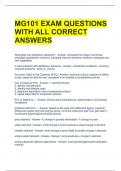MG101 EXAM QUESTIONS
WITH ALL CORRECT
ANSWERS
What goes into distribution decisions? - Answer- anticipate the margin economics,
anticipate competitors' reactions, anticipate channel members' reactions, anticipate your
own capabilities
2 main problems with distribution decisions - Answer- coordination problems - inventory
incentive problems - price vs. volume
Economic Value to the Customer (EVC) - Answer- maximum price a customer is willing
to pay, based on total life cost, compared to an existing or competitive products
how to measure EVC - Answer- 1. identify lifecycle
2. identify cost elements
3. identify total lifestyle costs
4. determine equivalent units of comparison product
5. repeat steps 2&3 for comparison product
EVC is helpful for... - Answer- pricing (price expectations), segmentation, new product
introduction
problems with EVC... - Answer- based on life cycle cost (difficult to figure), customer
differences (prefer short life and low price), convince customers (pay now, gain later!),
functional & psychological benefits ignored
price elasticity - Answer- % change in quantity demanded / % change in price
elastic demand - Answer- small change in price produces a large change in demand
inelastic demand - Answer- small change in price leads to smaller change in demand
unitary elastic demand - Answer- change in price produces = change in demand
pricing objectives different approaches - Answer- cost-oriented approaches (standard
markup)
, profit-oriented approaches (target profit)
competition-oriented approaches (above/at/below)
demand-oriented approaches (start with what consumer is willing to pay)
GO signal - Answer- thought/feeling/subconscious response that creates an approach
tendency and energizes the buyers towards the product (i.e. design, packing, brand
name)
STOP signal - Answer- thought/feeling/subconscious response that creates avoidance
tendency that inhibits considerations/purchase (i.e. risk, uncertainty, guilt)
2 main consumer insight (pricing) ERRORS - Answer- 1. signal side-effect neglect
(focus too much on one signal so overlook others
2. signal sensitivity neglect - acknowledge both signals, but neglect differential/relative
sensitivity of GO vs. STOP signals
behavioral pricing strategies - Answer- reducing pain of payment (mode of payment,
odd-even prices, round vs. precise payments), highlighting benefits maximization
(discounts vs rebates, shifting the "reference point"), the role of "fairness"
reference price - Answer- standard of comparison against which an observed price is
compared
internal causes of reference price - Answer- influenced by decision maker. experience
(last price you paid), knowledge (price often charged), price expectations (inflation),
price "fairness"
price fairness - Answer- cost-based vs. demand-based (price discrimination), cost of
raw materials vs. other costs (R&D, patent), demand a priori vs. demand, demand for
nonessentials vs. demand for essentials, demand-based pricing vs. supply-restriction
two types of promotions - Answer- incentives (creating values), persuasion
(communicating value)
incentives (promotion) - Answer- creating values: discounts, rebates, coupons, price
bundling, loyalty programs, placement
persuasion (promotion) - Answer- advertising, PR, direct marketing, personal selling
new media effects - Answer- market, mission, message, media, money, measurement
who you can target - Answer- customers, influencers, channels partners
major objectives of communication - Answer- build awareness, create associations,
develop motivation to act --> build brand equity (long term), increase purchase
intentions (short term)




